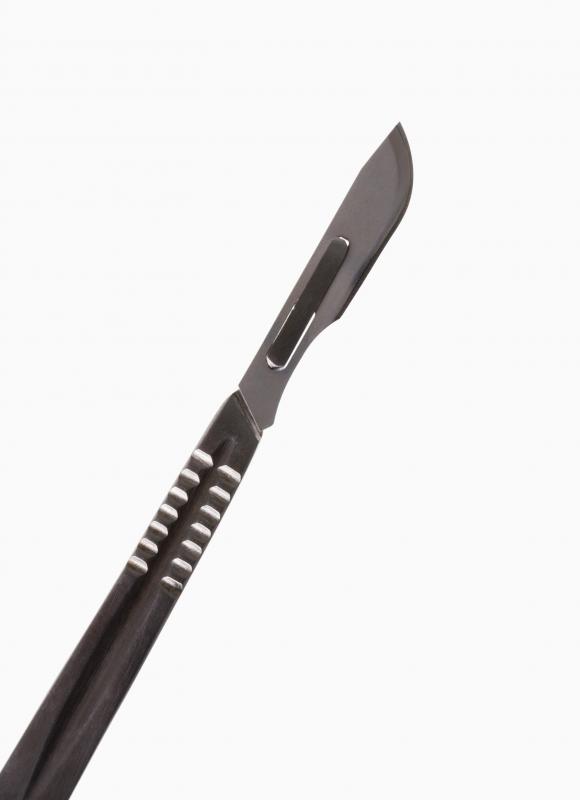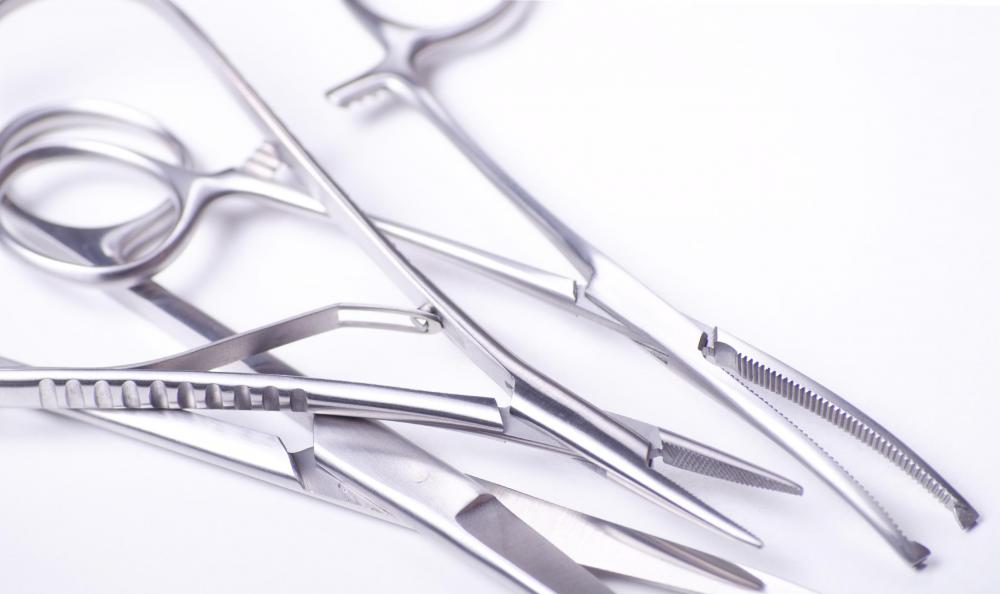At TheHealthBoard, we're committed to delivering accurate, trustworthy information. Our expert-authored content is rigorously fact-checked and sourced from credible authorities. Discover how we uphold the highest standards in providing you with reliable knowledge.
How Can I Remove Eyelid Warts?
Eyelid warts, or filiform warts, are usually removed by a medical professional by paring with a scalpel or scissors or freezing with liquid nitrogen. Additional options include curettage or light electrocautery. This variant of the common wart is characterized by long, narrow, and frondesque growths that can appear on the face, neck, and eyelids. Although they can be unsightly, eyelid warts are often easy to treat and usually benign.
The first step toward the removal of eyelid warts is to consult with a medical professional who can properly diagnose the presence of this type of growth. Such warts are long and slender with a visible base and projections that look like toothbrush bristles. These warts are likely to disappear without treatment after a few months, but there is no guarantee. They are typically asymptomatic, benign, and easy to treat, but patients should not attempt to remove them on their own because of the risk of damaging sensitive facial skin and surrounding tissues.

Instead of over-the-counter wart removal products, doctors can suggest alternative and safer treatments for eyelid warts. As these warts do not tend to manifest in clusters, treatment and removal are often as simple as paring. Paring involves cutting the wart off at its base with a scalpel or similar instrument, such as surgical scissors. A similar method involves removing the wart by scoping or scrapping the tissue with a curette. If the warts persist, more comprehensive treatment options may be considered.

An alternative treatment for filiform warts is freezing with liquid nitrogen, which should be applied so that approximately 0.08 inches (2 millimeters) of skin around the wart turns white. The skin will thaw in approximately 10 to 20 seconds, but blisters can form within two days of treatment. Additionally, there is a risk of hypopigmentation and permanent depigmentation associated with this type of treatment. Given that the eyelids are very fragile and sensitive, liquid nitrogen is not a common treatment option for eyelid warts.

Light electrocauterization is also used to treat filiform warts. This process destroys tissue via heat conduction from a needle. The needle is heated with electricity and then inserted into the wart. This treatment can cause scarring and is therefore not often used with eyelid warts.
Eyelid warts are caused by strains 1, 2, and 3 of the human papilloma virus (HPV). There are approximately 100 different strains of the HPV virus, and most spread through person-to-person contact. Skin damaged by a razor nick, scrapes, or dry weather is also vulnerable to HPV infection. Most types of warts will disappear on their own without treatment after a few weeks.

Over-the-counter wart removal medications should not be used on the face or neck. Many of these products contain ingredients that can damage or destroy the delicate eyelid skin as well as the wart. As filiform warts like eyelid warts form in sensitive areas, patients should seek medical treatment rather than attempt to remove these growths on their own.
Do Eyelid Warts Always Go Away on Their Own?

Most warts disappear on their own, but this process can take months or even years. The downside of waiting for an eyelid wart to go away on its own is that it increases the risks of contagion. Exposure to the sun can also cause the wart to keep growing, especially if you have a flat wart.
Warts can spread through touch. If you leave the wart untreated while waiting for it to go away, you’re taking the risk of infecting others and of having warts spread to other areas of your face or body.
Plus, an eyelid wart can look unsightly and even make it difficult to open your eye properly. Waiting also increases the risks of experiencing complications such as infection.
Even though your eyelid wart will eventually disappear after a while, it’s best to be proactive and schedule an appointment with a dermatologist to get rid of it.
How Can You Prevent Warts from Spreading?
You should avoid touching your eyelid. If you do, wash your hands immediately.
Don’t share towels and washcloths. In fact, it’s best to use separate washcloths and towels to dry the area where the wart is present.
Warts can spread easily through microtears in the skin. There is a high risk of contagion if you have an eyelid wart since the delicate skin around the eyes is more sensitive.
If you wear makeup, avoid applying products on the eyelid with the wart. The brushes and applicators could spread warts to other areas of your face. Plus, makeup could irritate the area and cause complications.
Zinc Supplements for Warts
Excising or freezing a wart is the best way to get rid of the abnormal growth. However, for stubborn warts that keep coming back, oral treatment with a zinc supplement can be a good option.
Zinc is safe and works well, especially for patients who suffer from recalcitrant warts. Researchers believe that zinc works by supporting the immune system and helping the body fight the HPV virus that causes warts.
If it’s not the first time you experience warts, you should talk about zinc supplements with your doctor.
Can You Get Rid of an Eyelid Wart With Tape?
Covering warts with a small piece of tape is a common home remedy. This method deprives the wart of air and sunlight and causes the cells to die. After a while, the wart will disappear. All you have to do is remove the tape once a week to wash and dry the area.
Tape can be an effective and inexpensive home remedy if you have a wart on your eyelid. You can cut a band-aid to cover the area. Plus, the tape or band-aid will prevent contact with the wart and can stop it from spreading.
There is no guarantee that this method will work. Most warts go away on their own and using tape can accelerate this process. However, if you’re dealing with a stubborn wart, using tape might not be enough.
Keep in mind that you should use a regular piece of tape or band-aid if you want to try this method. You can find some over-the-counter medicated patches to get rid of warts, but these products aren’t safe for using the eye area since they typically contain salicylic acid.
Salicylic acid can cause contact dermatitis if you apply it near your eyes. Contact dermatitis will cause an itchy rash to appear in the area. The rash will damage the skin and cause micro-tears that could result in warts spreading to the area.
Can You Use Essential Oils to Get Rid of an Eyelid Wart?
Essential oils are another popular home remedy for warts. Research suggests that compounds like carvacrol can help fight the HPV virus that causes warts. Neem oil, tea tree oil, and oregano oil are popular options.
However, essential oils aren’t safe for use around the eye area. Even if you dilute them with a safe carrier oil, you’re still taking the risk of irritating your skin.
Burning the delicate skin around your eyes by applying essential oil could cause dryness, flakes, and micro-tears that will increase the risks of the wart spreading. Even though essential oils can be a good home remedy for warts located in other areas, they’re not a good option for treating eyelid warts.
Conclusion
Because of the location, it’s unsafe to use topical wart treatment if you have a wart on your eyelid. Your best option is to see a dermatologist to have the wart removed or frozen and use a zinc supplement if warts are a recurring issue.
AS FEATURED ON:
AS FEATURED ON:















Discussion Comments
I treated my eyelid wart with salicylic acid. I applied salicylic acid on the wart with a cotton swab daily. It took a while, but the wart eventually disappeared.
@ysmina-- You will get the best advice from a dermatologist but I think that surgical excision might be the best option for you. All removal methods can cause scarring, so I don't think you can avoid that. But your doctor can give you a cream to use after the procedure to promote healing and prevent scarring. As for the eyelash issue, I have no idea. A doctor needs to see your wart.
I have an eyelid wart, it's located exactly where my eyelashes start.
I'm going to have it removed but I'm worried about scarring. I'm also scared that a part of my eyelashes will be removed along with the wart and they may not grow back.
What is the best wart treatment for me? Which method has the least likelihood of scarring?
Post your comments